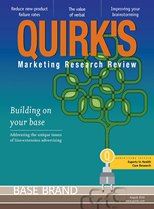Editor’s note: Chris St. Hilaire is cofounder and chief executive of MFour Mobile Research Inc.
The window may be closing on consumer surveys fielded online to personal computers but a new era for market research is opening wide on smartphones.
The evidence is in the numbers:
- As of late 2014, 15 percent of Americans ages 18 to 29 had cut the PC cord entirely and were “heavily dependent” on mobile alone for Internet access.
- The ownership of laptop or desktop computers is slumping, from 80 percent of U.S. adults in 2012 to 73 percent in 2015 – the lowest market saturation for PCs since before the Great Recession.
In addition to the statistics above (compiled by the Pew Research Center), Intel’s recent announcement that it’s de-emphasizing its memory chips for PCs – the product that made it a corporate giant – makes for a good case that the PC’s sun is setting. The company that knows PCs from the inside realizes that the future lies in mobile devices and the cloud.
Movement within the industry
The American Revolution unshackled a new country from an outmoded form of government. In a nutshell, 2016 has the potential to be a revolution-sized moment for this industry. The mobile revolution is already beginning to free market research from the demographic and technological constraints of online studies and presenting researchers with access to fast, accurate and representative data.
It is a blueprint for failure to claim today that online market research data is representative and accurate. Online MR has been known to struggle when looking to reach vital, rising consumer demographics such as Hispanics and the Millennials who practically live on their smartphones. The industry needs to optimize mobile methods at both ends of the research equation. First, it must continue to perfect survey software that specifically taps the computing power and multimedia capacities of today’s smartphones. Second, it must cultivate high-quality, demographically diverse panels and keep them engaged by tailoring mobile surveys to display simply but elegantly, and work effortlessly on the devices that have become a fifth appendage.
An all-mobile approach that uses the best technology and best practices can revitalize the survey-fielding process at every step, from panel recruitment to data return. Recruitment becomes fast and efficient. With all-mobile, panelists get a push alert – a text message that there’s a survey to take. This solves an inherent problem of online surveys’ standard e-mail notifications – they’re very easy to miss or ignore. For recruiting Millennials, who opt for texting over e-mail, the gap in effectiveness between texted pushes and e-mail notifications becomes even greater.
Advancing technology
A common misconception about mobile surveys is that they must be kept short because they’re easily dropped when the respondent can’t get a good enough signal to speed the survey along or can’t access Wi-Fi. This may be true of some systems but when technology is built around native apps that load the entire sequence of questions instantly into panelists’ phones – including pictures and audio/video content – respondents can answer while they are offline, no signal or Wi-Fi needed.
Submitting the completed survey can also be instantaneous. Smartphone capabilities like this can keep respondents from the frustrations of less-advanced mobile technologies that require a separate, one-at-a-time online interchange and load-in for each question and answer.
Multimedia components in mobile surveys dovetail with smartphone users’ delight in their devices’ cameras and audio-video recording and playback functions. Researchers can test respondents’ willingness to receive questions based on pictures or clips sent to their phones with survey questions – or create and submit their own multimedia content to enhance an answer.
Mobile can also put smartphones’ geolocation and multimedia features at a researcher’s disposal. When allowed, it can pinpoint panel members at locations that are relevant to a study, such as a retail chain store or a cinema. Researchers can then field a survey on the spot or soon after respondents have left. The result is vivid, quick responses, generating data that won’t be skewed by faulty recall.
All-mobile surveys give market research a new, two-way street to give respondents a more flexible and engaging experience. For researchers, mobile drives faster, more efficient access to more reliable data and opens new avenues into consumers’ in-the-moment thoughts and emotions.
